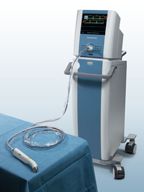New Device May Reduce Additional Surgeries in Breast Cancer Patients
A new device called MarginProbe may soon be available to help surgeons determine the minimal amount of tissue to be removed during a lumpectomy and reduce re-excision rates.
A new device may soon be available to help surgeons determine the minimal amount of tissue to be removed during a lumpectomy. The tool is designed to detect cancer tissue margins during actual surgery. The balance of removing enough tissue to have resulting negative margins but not too much in order to preserve a woman’s breast is a challenge in lumpectomy. Generally, less tissue is removed which can result in a need for re-excision.

The new device could reduce the need for further surgeries in breast cancer patients
A large, prospective trial presented at the American Society of Clinical Oncology (ASCO) Breast Cancer Symposium, held in San Francisco, shows that when the MarginProbe device is used during surgery, re-excision rates are significantly lower than when no device was used. Fewer follow-up surgeries can translate to better preservation of the overall appearance of the breast following the lumpectomy and to a reduced risk. Previous techniques have all resulted in extra normal tissues excision.
“The main issue is that these areas of positive margins are only seen under the microscope,” explained Susan K. Boolbol, MD, chief of the division of breast surgery at Beth Israel Medical Center and a senior author on the study. “In the operating room we rely on the gross assessment of the [removed tissue]. We look at the tissue and feel the tissue. If we see or feel the cancer near one of the margins, we can remove more tissue at that time. If we do not feel or see cancer at the margin, we do not remove any more tissue, and we then wait for the pathology report.” But with ductal carcinoma in situ (DCIS), surgeons cannot feel the mass, resulting in much less information in the operating room, said Boolbol.
Women with invasive carcinomas or DCIS who do not have a high risk of recurrence undergo a lumpectomy followed by radiation therapy rather than a mastectomy. Currently, a pathology review for negative or positive margins is done postsurgery. Re-excision is necessary if positive margins-cancer cells left in the margin of the excised tissue-are found. Typically between 30% and 60% of women need to undergo a second surgery to remove the positive margins.
The results of this trial suggest that margin analysis can be readily done with the MarginProbe device during the initial lumpectomy to obtain negative margins without the need for secondary surgery.
A total of 596 patients with either DCIS or invasive carcinoma undergoing a lumpectomy were randomized to analysis with the device or no analysis. The device was used on the main lumpectomy specimen and if positive margins were detected, patients were further resected while in the operating room. The study was conducted internationally at 21 cm.
The decrease in the frequency of re-excision between the experimental device and control arms was statistically significant. Of the 161 women in the study who had only DCIS, 13% of those in the device group needed re-excision compared to 37% of those in the control arm (P = .004). For the 334 women with both DCIS and invasive carcinoma, 17% of those in the device arm needed re-excision compared to 33% in the control arm (P < .001).
Assessing the final impact on the patient, the study found the total tissue, including initial lumpectomy and any subsequent resectioning in patients was the same in both the experimental and control groups. “This is a very important point-we must keep the cosmetic outcome in mind,” said Boolbol.
Boolbol believes that the learning curve for using the device is not high. “One of the advantages of this device is its ease of use,” she said. Overall, using the device added about 5 minutes of time to an operation.
More studies are likely needed to demonstrate the utility of MarginProbe, said Boolbol. The US Food and Drug Administration’s (FDA) advisory panel recently gave MarginProbe a positive recommendation. The manufacturer, Dune Medical Devices, filed a premarket approval with the FDA in May of 2011 but it is not yet approved by the FDA.